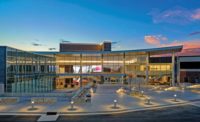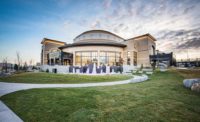The Bob & Renee Parsons Leadership Center for Girls and Women at Camp South Mountain
Phoenix
Best Project, Cultural/Worship
Key Players
Owner/Developer: Girl Scouts—Arizona Cactus-Pine Council Inc.
Design Firm: Marlene Imirzian & Associates Architects
General Contractor: The Weitz Co.
Civil Engineer: Kland Civil Engineers
Structural Engineer: Bakkum Noelke Consulting Engineers
MEP Engineer: Kraemer Consulting Engineers
Nestled in the foothills of South Mountain in Phoenix, the Girl Scouts—Arizona Cactus-Pine Council has created a state-of-the art camp and leadership center that embraces not only the young women it serves but also the desert Southwest.
“Every community member and volunteer that comes on the campus is wowed, and we have no word for it but magic,” says Deb Esparza, senior associate, general operations at the Girl Scouts—Arizona Cactus-Pine Council.
The $16-million Parsons Leadership Center offers space for meetings and gatherings, including approximately 38,000 sq ft of new and renovated buildings.
The camp includes 15 sleeping cabins with 10 beds each, three activity cabins, a demonstration kitchen and kitchen garden, two pools, a Girl Scout museum and shop, staff offices, an expansive play field, archery range, campfire circle, stone amphitheater and two labyrinths.
Each ADA-compliant cabin is sited to replicate the jagged mountain landscape, while slanted, V-shaped roofs are designed to collect rainwater for surrounding plants.
The primary building material on the exterior shell and for connecting the structures is composite board and decking that required no finishing and is expected to last for decades.
Unique and Standard Challenges
A major contributor to the magic potion that the development and construction teams were able to employ through this project came directly from current and former Girl Scouts, Esparza says, including funding and construction development. She adds that current Girl Scouts donated all proceeds from cookie sales directly to the project for three years.
Even more important, she says, was the fact that former Girl Scouts held leadership positions at architect Marlene Imirzian & Associates Architects and general contractor Weitz Co.
“They had values that aligned with our values,” Esparza says. “Both organizations. We were able to align with partners that not only thought the way we did, but felt the way we did. It was the right thing to do because we wanted to make a statement that investment in girls is important to our community and our world.”
Former Girl Scout Marlene Imirzian was hired to master plan and design the facility in 2010 as the recession took hold; the entire project was planned under a variety of funding scenarios.
But despite the obstacles, the Girl Scout organization acronym GIRL, which stands for go-getter, innovator, risk-taker and leader, influenced what Imirzian developed and proposed for the new facility.
“Every building was going to be a demonstration of how we build for the desert,” Imirzian says. “Why do we build a traditional roof where you want [to remove] the snow?”
Desert Rains
One of the other most important elements was to accommodate rain runoff from the mountain while maintaining the complex as a desert oasis, Imirzian says.
“Early on, we moved to the raised system so the desert floor could be protected and the animals could move and the water could move under these decks as it always had done,” she says.
The master plan of raised, connected decks and elevated cabins would protect the desert floor during the life of the facility, but digging the approximately 300 caissons without impacting the desert became a significant challenge for general contractor Weitz Co.
Even though the site was in mostly untouched desert, the construction footprint was limited to the building’s footprint as much as possible.
“It was very tricky logistics-wise to get the caissons in,” says Samantha Vark, project engineer at Weitz.
Installing the caissons, which were set as deep as 14 ft deep over varying elevations, challenged the contractors. The team modified construction techniques on the fly, using shotcrete within excavations to prevent walls from collapsing and developing custom tie-off methods for workers around openings.
Donations Go Forward
Although the project had a variable master plan in the concept phase, after a $5-million donation by Bob and Renee Parsons—the largest single donation in Girl Scouts history—the project was slated for a single phase. Construction was finished in 22 months in January 2017.
But even the Parsons’ donation and cookie sale proceeds were not enough to fully pay for the $16-million project.
The Weitz Co. donated substantial services and hosted two tournaments at a nearby golf course that raised $50,000. The firm also embraced project tours for donors and community stakeholders that became weekly events by the project’s end.
“When you can touch and feel a project, it is a lot easier to give than something you can’t see and experience,” says Samantha Pinkal, business development manager for Weitz.
Fundraising for the project is ongoing and includes additional matching funds by the Parsons. Visit girlscoutsaz.org/campaign for more information.
Related Article: Pursuing Excellence Drives Best Projects






